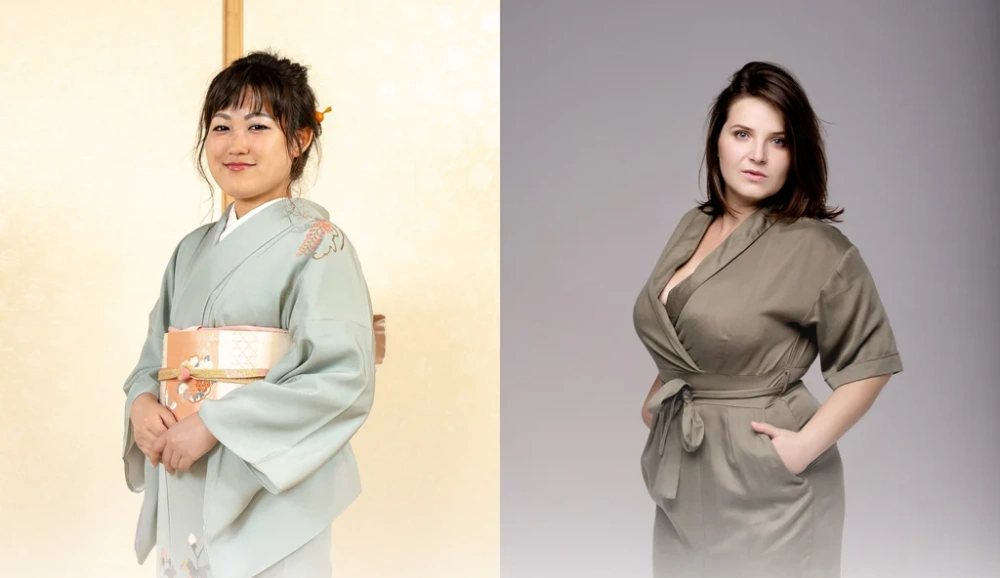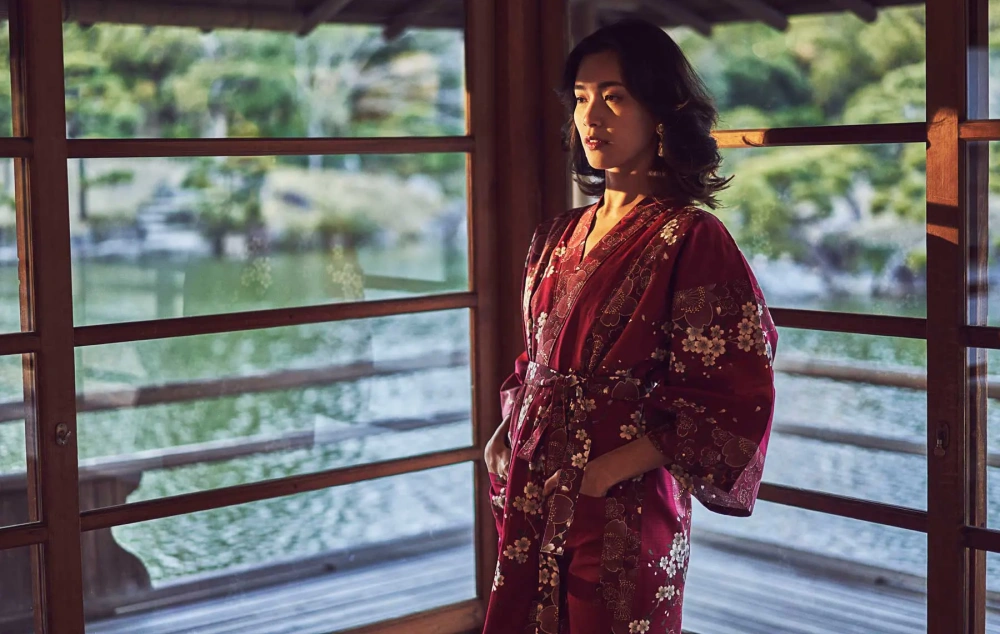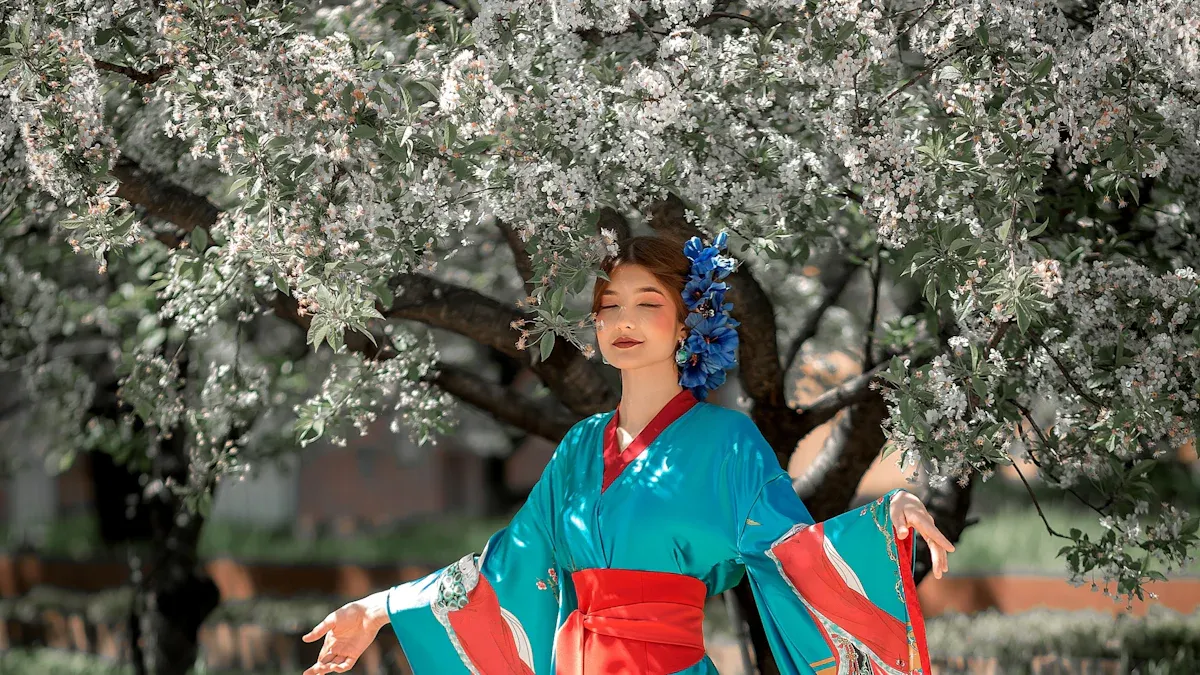
When you face the kimono vs robe decision, think about what feels right for your lifestyle and taste. Kimonos give you a blend of elegance and cultural flair, inspired by the traditional Japanese garment, while a robe often puts comfort and practicality first. Y
You might notice floral kimono styles popping up everywhere, especially as loungewear grows in popularity. Your choice comes down to style, fabric, and how you want to use your garment—maybe you want something with a rich story, or perhaps you just want to relax in a cozy robe.
The best fit matches your needs, mood, and sense of style.
Key Takeaways
Kimonos offer elegant style and cultural meaning, while robes focus on comfort and everyday use.
Choose fabrics like silk or cotton for kimonos and cotton or bamboo for robes to match your comfort and season.
Kimono robes suit special occasions and stylish lounging; classic robes work best for relaxing at home or after a bath.
Find the right fit by considering your body type, size options, and personal style preferences.
Proper care, like gentle washing and air drying, keeps your robe soft and lasting longer.
Kimono vs Robe Overview
When you start thinking about the kimono vs robe debate, it helps to see the basics side by side. Both garments offer comfort and a loose fit, but they come from very different backgrounds and serve different purposes. Let’s break it down with a quick table:
Aspect | Kimono | Robe |
|---|---|---|
Design | High-quality silk or cotton, intricate patterns | Cotton, silk, polyester, simple or plain patterns |
Function | Formal events, ceremonies, or as a stylish cover-up | Lounging, after bathing, or casual home wear |
Cultural Significance | Deeply tied to Japanese heritage and social status | No specific cultural ties, mainly functional |
Fit | Loose, elegant, often floor-length | Loose, practical, various lengths |
You’ll notice that a kimono often stands out with its detailed designs and luxurious fabrics. It’s not just clothing—it’s a symbol of Japanese identity and tradition. You might wear a kimono for special occasions like weddings or tea ceremonies.
On the other hand, a robe is all about comfort and ease. You probably reach for your robe after a shower or when you want to relax at home.
Quick Comparison Table
If you’re curious about price, there’s a wide range depending on the brand and material. Some robes are very affordable, while traditional kimonos can be extremely expensive due to their craftsmanship. Here’s a quick look at how prices compare:

Key Differences
So, what are the key differences you should keep in mind? First, the kimono vs robe question is about more than just looks. Kimonos carry deep cultural meaning and are often made of luxurious materials.
Robes focus on practicality and comfort, with simple designs and easy care. You’ll find that a kimono feels special and unique, while a robe is your go-to for everyday relaxation. Knowing these key differences helps you pick the best fit for your needs and style.
Kimono, Robe, and Kaftan Explained
What is a Kimono?

When you picture a kimono, you might see a flowing, elegant robe with wide sleeves and a sash called an obi. The traditional Japanese kimono stands out as a symbol of identity and tradition. This traditional Japanese garment has deep roots in kimono culture, with each detail reflecting centuries of history.
Women’s kimonos often have longer sleeves, especially for formal events, while men’s sleeves stay shorter. You’ll notice symbolic colors—red for joy, black for formality, blue for calm, and gold for prosperity. Traditional elements like intricate dyeing, weaving, and seasonal motifs make every kimono unique.
Wearing a kimono involves special rituals and accessories, showing respect for tradition. Over time, modern kimono robes have changed things up. Designers now use easier-care fabrics, shorter hemlines, and looser fits. You can even find hybrid styles that blend traditional elements with Western fashion.
These modern kimono robes let you enjoy the beauty of the kimono in everyday life, not just on special occasions. Friendtex specializes in crafting modern kimono robes that honor tradition while offering comfort and style for today’s world.
What is a Robe?
A robe feels familiar and cozy. You probably reach for one after a shower or when you want to relax at home. Robes have their cultural origins, starting in ancient China as luxury silk dressing gowns for the wealthy. Over time, robes became more about comfort than status.
Unlike the traditional Japanese kimono, robes don’t carry deep cultural meaning. They focus on practicality, with loose designs and soft fabrics like cotton, fleece, or bamboo.
Today, you’ll find robes in many styles—bathrobes, spa robes, and even modern kimono robes inspired by Japanese fashion. Friendtex offers summer robes and bamboo robes that combine comfort, breathability, and a touch of luxury, perfect for your daily routine.
What is a Kaftan?
A kaftan brings its own flair to the mix. This garment comes from the Middle East and North Africa, known for its loose fit and flowing silhouette. You’ll see kaftans made from lightweight fabrics, often decorated with bold prints or embroidery. People wear kaftans for both casual lounging and festive occasions.
While the kaftan doesn’t share the same tradition as the kimono, it does offer a relaxed, stylish option for warm weather. Some modern kimono robes borrow ideas from kaftans, blending traditional elements from different cultures to create something new and exciting.
Tip: If you love the elegance of a traditional Japanese kimono but want something easy to wear every day, try a modern kimono robe from Friendtex. You get the best of both worlds—timeless style and modern comfort.
Kimono Robe vs Classic Robe: Key Differences

Design and Structure
When you look at a kimono robe and a classic robe side by side, you notice the difference right away. A kimono robe has a T-shaped silhouette, wide sleeves, and a straight, flowing body. You slip your arms through the sleeves, center the back seam, and wrap the left side over the right.
The collar sits about an inch from your neck, and you secure the robe with sashes like the koshi-himo and datejime. This method keeps the kimono robe in place and gives it a neat, elegant look.
A classic robe, on the other hand, keeps things simple. You usually find a belt or tie at the waist, and the sleeves are often wider and more open. The closure is quick and easy, perfect for when you want to relax after a shower or just lounge around.
The structure of a classic robe focuses on convenience and comfort, while the kimono robe brings a sense of tradition and careful detail to your daily routine.
Tip: If you want a robe that feels special and looks unique, try a kimono robe. If you prefer something quick and easy, a classic robe might be your best friend.
Fabric and Material
The fabric you choose can change everything about how your robe feels and lasts. Kimono robes often use silk or satin, which feel soft, smooth, and lightweight.
These fabrics give you a sense of luxury and elegance, but they need gentle care. Friendtex offers kimono robes in premium silk, cotton, and even blends that balance comfort with easy care. You can also find linen and bamboo robes, which are breathable and perfect for warmer days.
Classic robes usually come in cotton, terry cloth, or synthetic blends. Cotton is soft, absorbent, and hypoallergenic, making it great for bath time.
Terry cloth is thick and cozy, while microfiber and polyester blends dry quickly and resist wrinkles. Linen robes from Friendtex offer a cool, airy feel, and bamboo robes bring natural softness and moisture-wicking power.
Here’s a quick look at some common fabrics:
Fabric Type | Features | Best For |
|---|---|---|
Silk/Satin | Smooth, lightweight, elegant | Kimono robe, luxury silk robe |
Cotton/Terry Cloth | Soft, absorbent, breathable | Classic robe, modern bathrobe |
Linen | Cool, airy, moisture-wicking | Summer robe, linen robe |
Bamboo | Soft, eco-friendly, antimicrobial | Bamboo robe, summer robe |
Microfiber/Polyester | Quick-drying, durable | Classic robe, modern bathrobe |
You get to pick the fabric that matches your needs—whether you want the elegance of a kimono robe or the practicality of a classic robe.
Comfort and Fit
Comfort matters most when you’re choosing a robe. Kimono robes feel lightweight and breathable, especially when made from silk or cotton.
The flat collar and straight cut give you freedom to move, and the robe drapes beautifully on many body types. Friendtex designs kimono robes to flatter all shapes, with options for petite and larger sizes.
Classic robes come in many lengths and fits. You can pick a full-length robe for warmth or a short robe for hot days. Cotton and terry cloth robes feel cozy and snug, perfect for chilly mornings.
Linen and bamboo robes from Friendtex offer a relaxed fit and keep you cool in summer. The weave and thickness of the fabric also affect how the robe feels. Tighter weaves feel smoother but may trap heat, while open weaves let your skin breathe.
Here’s a quick comparison:
Kimono robe: Lightweight, stylish, drapes well, best for layering or lounging.
Classic robe: Cozy, warm, easy to wear, great for after a bath or shower.
Summer robe: Light, airy, perfect for hot weather.
Linen robe: Breathable, soft, gets better with each wash.
Bamboo robe: Silky, moisture-wicking, gentle on sensitive skin.
You can always find a robe that fits your body and your lifestyle, especially with the range of sizes and custom options from Friendtex.
Cultural Significance
A kimono robe carries a story. In Japan, the kimono stands for tradition, artistry, and identity. Every color and pattern means something, from cherry blossoms for new beginnings to cranes for long life.
Wearing a kimono robe connects you to this rich history, even if you’re just relaxing at home. The way you wrap and tie the robe shows respect for tradition and attention to detail.
Classic robes don’t have the same cultural weight. They focus on comfort and daily use. In the West, a classic robe or modern bathrobe means relaxation, self-care, and a bit of luxury.
Over time, the kimono robe inspired new styles of bathrobes, blending Japanese elegance with Western comfort. Now, you can enjoy a kimono robe as a symbol of both heritage and modern living.
Note: Whether you choose a kimono robe for its beauty or a classic robe for its ease, you’re picking a garment that fits your story and your needs.
Choosing the Best Fit for You
Occasion and Use
Think about when and where you want to wear your robe. If you love a touch of elegance at home or want to impress guests during a gathering, a kimono or a kimono robe can turn any moment into something special.
Many people choose a kimono robe for daily lounging, hosting friends, or even as a chic cover-up for a spa day. Brides and bridesmaids often pick these robes for wedding mornings because they look beautiful in photos and feel luxurious.
Classic robes work best for everyday comfort, after a shower, or when you just want to relax. If you want something that feels a bit more elevated, go for a kimono robe. For pure coziness, a classic robe is your best friend.
Body Type and Sizing
You deserve a robe that fits you perfectly. Friendtex offers robes in a wide range of sizes, from petite to plus-size, so everyone can find their match. You’ll see options like tailored, unisex, and even adjustable robes with belts or elastic waists.
Plus-size robes have extra room in the bust, hips, and arms, while petite robes avoid extra fabric and have shorter sleeves. If you want a robe that hugs your shape, look for styles with a snug fit.
Prefer something relaxed? Unisex and kimono robes give you that loose, comfortable feel. No matter your body type, you’ll find a robe that feels just right.
Style and Personal Preference
Your style should shine through, even in your loungewear. Kimono-style robes are trending for their loose fit, tie closures, and beautiful patterns. You might love a floral print or a bold color. Classic robes come in plush fabrics like velvet or terry cloth, perfect for a cozy night in.
Cotton robes are great for breathability and come in many colors and patterns. If you want to personalize your robe, Friendtex lets you customize everything from fabric to embroidery. Don’t be afraid to add accessories like scarves or jewelry to make your look unique. Express yourself and pick a style that matches your mood.
Seasonality and Fabric Choice
The right fabric makes all the difference. For summer or warmer climates, choose lightweight robes made from linen, cotton, or bamboo. These fabrics breathe well and keep you cool, even after a spa day.
Silk robes work year-round, offering a smooth, comfortable feel in both hot and cool weather. When winter comes, reach for a robe made from plush velvet, flannel, or lined cotton for extra warmth.
Waffle weave robes are perfect for warm weather because they let air flow and wick away moisture. Always match your robe’s fabric to the season for the best comfort.
Tip: Friendtex offers robes in all these fabrics, so you can find the perfect match for every season and occasion.
Care and Maintenance Tips
Taking good care of your robe keeps it looking fresh and feeling soft for years. Whether you have a kimono robe, a linen robe, a bamboo robe, or a summer robe from Friendtex, a few simple habits make a big difference.
Washing and Drying
You want your robe to stay beautiful and last longer. Here’s how you can wash and dry it the right way:
Always check the care label before washing your robe.
For silk or bamboo robes, hand washing works best. If you use a machine, pick the delicate cycle and place your robe in a mesh laundry bag.
Use a mild detergent made for delicate fabrics. Avoid bleach and harsh chemicals.
Wash your robe with similar fabrics and turn it inside out to protect the surface.
After washing, never wring or twist your robe. Gently press out water with a towel.
Lay your robe flat to dry in a shaded spot. Keep it away from direct sunlight to prevent fading.
Skip the high-heat dryer. Air drying helps your robe keep its shape and softness.
Tip: For robes with embroidery or special details, professional dry cleaning is the safest choice.
Longevity and Fabric Care
A little extra care goes a long way. You can keep your robe looking new by following these tips:
Store your robe in a cool, dry place. Use a breathable garment bag to avoid moisture and moths.
Hang your robe on a padded hanger to keep its shape.
Avoid handling your robe with oily hands to prevent stains.
Spot clean small stains right away. Use a gentle fabric refresher spray if needed.
For wrinkles, use a steamer or iron on the lowest setting.
Check your robe for loose threads and snip them carefully—never pull.
If you rotate your robe use and let it air out between wears, you help prevent odors and mildew. These habits keep your robe soft, colorful, and comfortable every time you wear it.
Sustainability and Quality with Friendtex
Eco-Friendly Materials
You want your robe to feel good and do good for the planet. Friendtex makes that easy. The brand uses natural, breathable fabrics that are gentle on your skin and kind to the environment.
When you slip into a Friendtex kimono robe or classic robe, you can trust that the fabric comes from sustainable sources. Take a look at some of the eco-friendly materials you might find in your next robe:
Material Type | Description | Eco-friendly Attributes |
|---|---|---|
100% Linen | Pure natural linen fabric used in robes, soft, lightweight, breathable, moisture-wicking | Natural fiber, sustainable, breathable, soft |
Linen-Cotton Blend | A combination of linen and cotton offering durability and comfort | Natural fibers, breathable, durable |
Linen-Bamboo Blend | A blend of linen and bamboo provides softness and moisture-wicking properties | Natural fibers, eco-friendly bamboo, breathable |
These fabrics help you stay comfortable all year long. Linen keeps you cool in summer and cozy in winter. Bamboo adds extra softness and helps wick away moisture. You get a robe that feels great and supports a greener future.
Certifications and Quality Assurance
You want to know your robe meets high standards. Friendtex takes quality and sustainability seriously. The company holds several important certifications that show its commitment to both people and the planet:
BSCl
WARP
SEDEX
GOTS
Friendtex also works with professional third-party agencies to check quality and safety. These certifications mean you can trust your robe to be safe, responsibly made, and long-lasting. When you choose Friendtex, you support a brand that cares about the environment and delivers premium quality every time.
Tip: Choosing a robe from Friendtex means you get comfort, style, and peace of mind—all in one package.
Conclusion
Choosing between a kimono and a robe comes down to your style, comfort, and how you plan to wear it. Here’s a quick look at what matters most:
Decision Point | Kimono Robe | Classic Robe |
|---|---|---|
Style | Elegant, versatile | Cozy, practical |
Occasion | Lounging, outings | Home, spa, bath |
Fabric | Silk, cotton, satin | Cotton, bamboo |
Quick Tips:
Think about where you’ll wear it—indoors, outdoors, or both.
Pick a fabric that feels good on your skin.
Want something unique? A kimono robe makes a special gift and adds flair to your routine.
You’ll find the perfect fit with Friendtex, whether you want everyday comfort or a touch of luxury.
FAQ
How do I know if a kimono robe or a classic robe fits me best?
Try both styles if you can. A kimono robe gives you a relaxed, elegant look. A classic robe feels cozy and practical. Think about your daily routine and what makes you feel comfortable.
Can I wear a kimono robe outside the house?
Yes! You can style a kimono robe as a lightweight jacket or a chic cover-up. Pair it with jeans, dresses, or even swimwear. It adds flair to any outfit.
What’s the easiest way to care for my robe?
Check the care label first. Most robes do well with cold or lukewarm water and gentle detergent. Air drying helps keep the fabric soft and fresh. Avoid bleach to protect the colors.
Are Friendtex robes good for sensitive skin?
Absolutely. Friendtex uses hypoallergenic fabrics like bamboo, cotton, and silk. These materials feel gentle and soft. You can wear them even if your skin is sensitive.
Can I personalize my robe from Friendtex?
You sure can! Friendtex offers customization options. You can choose embroidery, colors, and even add your logo. This makes your robe unique and special.


